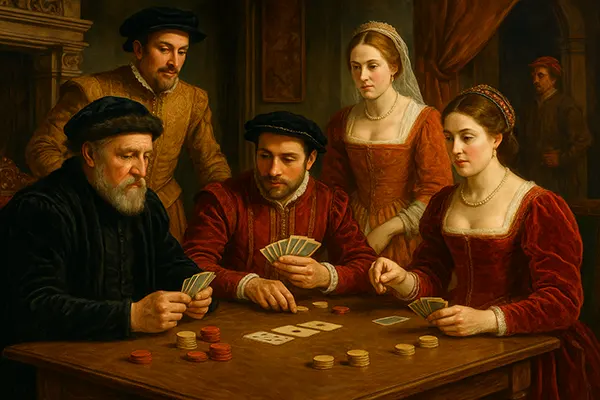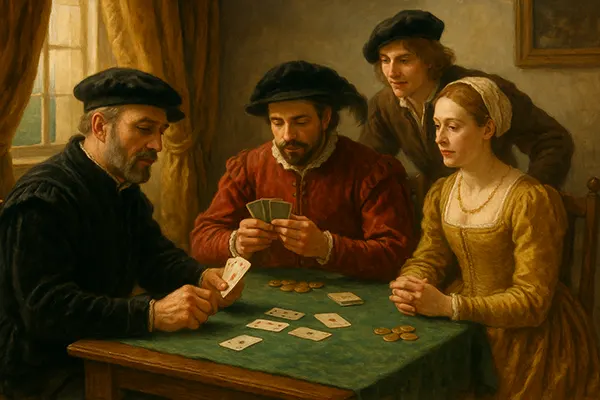
Roots of the “First Cards”: Primero — The Ancestor of Poker
Primero, a 16th-century Italian card game, holds a distinguished place in the history of card playing as one of the earliest known ancestors of modern poker. Popular among European nobility, it became particularly fashionable in the Tudor court, where it was played by monarchs, courtiers, and the upper classes. With its emphasis on bluffing, calculated risk, and reading opponents, Primero laid the groundwork for many principles still found in poker today. Historical references, including mentions in Shakespeare’s plays, confirm its prominence in the cultural and social life of Renaissance Europe.
The Origins and Historical Spread of Primero
Primero is believed to have emerged in Italy around the early 1500s, before spreading to Spain, France, and eventually England. Its name, meaning “first” in Italian and Spanish, symbolised its place as one of the earliest structured card games in Europe. Played with a 40-card deck, the game excluded eights, nines, and tens, creating a streamlined set of cards that influenced strategic decision-making. The structure and pace of Primero made it an engaging blend of chance and skill.
By the mid-16th century, Primero had become a favourite at the Tudor court in England, famously enjoyed by King Henry VIII and later by Elizabeth I. It was often played in small groups, with wagers that could vary from modest stakes to substantial sums, depending on the players’ means and the occasion. The game was as much about social interaction and reputation as it was about winning.
Primero’s appeal lay in its balance of simplicity and strategic depth. Players had to master both the value of their hands and the art of bluffing, making psychological insight just as important as mathematical calculation. This dual focus set a precedent for many card games that followed, including poker.
Rules and Gameplay of Primero
The rules of Primero differed slightly across regions, but the core gameplay involved each player being dealt four cards, with betting rounds in between. The objective was to have the highest-ranking combination of cards, but players could also win by convincing opponents to fold through strategic betting or feigned confidence. Hands included combinations such as primos (four cards of the same suit) and flushes, which predate similar hands in modern poker.
A notable element was the use of “vying” — a betting tactic where players could raise the stakes based on the perceived strength of their hand. This mechanic not only added suspense but also introduced a psychological element that encouraged bluffing. It is here that we see the roots of poker’s signature tension between truth and deception.
The fast pace of Primero was another of its defining features. Unlike some other games of the era, rounds were quick, keeping players engaged and encouraging more frequent betting exchanges. This pace contributed to the game’s popularity among the nobility, who valued entertainment that combined intellect with excitement.
The Cultural Significance of Primero
In the 16th century, card games were not merely a pastime but a reflection of one’s social standing and education. Primero, in particular, became a symbol of sophistication and strategic acumen. To be skilled at the game was to demonstrate wit, composure, and an understanding of human behaviour — qualities highly esteemed in Renaissance courts.
Its popularity in England coincided with the golden age of theatre, literature, and art. Shakespeare’s references to Primero in works such as “Henry VIII” and “The Merry Wives of Windsor” serve as cultural markers of the game’s status. These mentions also suggest that audiences of the time were familiar with the game’s mechanics and its association with courtly life.
In Spain and Italy, Primero’s role extended to gatherings among merchants and politicians, making it a game that crossed class boundaries while maintaining an air of exclusivity in certain circles. Its ability to bridge entertainment and subtle competition made it a fixture in social events for decades.
Primero in the Tudor Court
At the English court, Primero was more than entertainment — it was a stage for diplomacy, subtle rivalry, and even discreet political manoeuvring. Games could last for hours, with participants using them to discuss alliances, share news, or gauge rivals’ intentions under the guise of casual play.
Historical accounts suggest that the game was often played during festive occasions, banquets, and private royal gatherings. The stakes could be high, and winnings or losses were sometimes noted in court records, emphasising the financial as well as the social weight of the game.
For the Tudor elite, mastering Primero was as much about projecting confidence and grace under pressure as it was about securing victory. This mirrors poker’s modern role in competitive settings, where composure can be as decisive as the cards themselves.

From Primero to Modern Poker
Although Primero eventually declined in popularity by the late 17th century, its influence on later card games is undeniable. As it spread across Europe, local variations evolved, incorporating new rules and expanding the number of cards in the deck. Over time, these changes gave rise to games like poque in France and primero-derived variants in Spain, which would contribute directly to the creation of poker in 19th-century America.
The game’s legacy lies in its foundational mechanics: limited cards, ranked hands, betting rounds, and the central role of bluffing. These principles remain at the heart of poker today, whether in casual home games, professional tournaments, or online play.
Modern poker owes much to Primero not only in terms of structure but also in its cultural positioning as a game of intellect, nerve, and social skill. By studying Primero, we gain insight into how games evolve alongside societies, adapting to new contexts while retaining their core appeal.
The Enduring Legacy of Primero
While few today actively play Primero, its historical significance is recognised by gaming historians and cultural scholars. Museums, academic papers, and even reenactments at heritage events continue to celebrate the game’s role in shaping the history of cards.
For enthusiasts of poker and card history, Primero represents a fascinating chapter in the evolution of competitive play. It reminds us that the roots of modern gaming lie deep in the cultural exchanges, political intrigues, and leisurely pursuits of centuries past.
As poker continues to evolve in the 21st century, understanding its lineage enriches our appreciation of the game. Primero may have faded from the card tables of Europe, but its influence lives on in every bluff, every calculated raise, and every winning hand in poker today.
